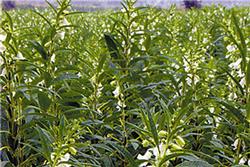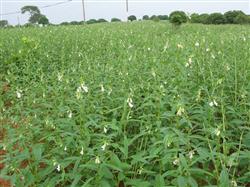What can prevent sesame leaf blight?

What can prevent sesame leaf blight? Please introduce the distribution and damage of sesame leaf blight: it occurs in all sesame producing areas in China. The disease is caused by the fungus Corynespora hyacinth. In addition to harm sesame, but also harm soybeans, straight beans and other crops. Symptoms/morphological characteristics: after seedling damage, leaf stem dies; damaged leaves produce small brown spots at the beginning, then turn pale brown angular spots, or do not shape large spots, and have inconspicuous whorls and brown mold layers, i.e. conidia and conidia of the pathogen; the spots on stems are brown, fusiform or linear, with a concave center; the spots on capsules are reddish brown or purple, slightly concave. Pathogen overwinters in conidia and hyphae on seeds or diseased plant residues. Mycelia on seeds can survive for more than 2 years, conidia on diseased bodies still have %% survival rate after one year. Conidiospores spread by wind and rain, carrying out primary infection and multiple reinfection. The optimum temperature for growth of the pathogen was 27-30℃. When the plant growth is weak and the field humidity is high, the disease is serious. Control methods: 1. Agricultural measures to remove the residues of diseased plants in the field, deep return to the land; avoid planting sesame in low-lying land; select seeds from disease-free land; strengthen cultivation management, reasonably plant closely, increase organic fertilizer and phosphorus and potassium fertilizers, clear ditches and drain water to reduce field humidity. 2. At the early stage of disease control, spray 40% carbendazim colloidal suspension 700 times solution, or 25% carbendazim WP 500 times solution, or 70% mancozeb WP 600 times solution, or 70% thiopril methyl WP 700 times solution, etc. It is best to spray once at flowering stage and before capping. Click for more sesame cultivation technology Click for more grain crop cultivation technology
- Prev

What should be paid attention to in sesame planting?
What should be paid attention to in sesame planting? Please introduce sesame in detail, which is rich in protein, vitamins, iron, calcium, sesame phenols and other substances. It is rich in nutrition and rich in aroma. It is an indispensable ingredient for making cakes and characteristic foods. Sesame oil is a rare excellent edible oil. Sesame is a joy.
- Next

How to apply micro-fertilizer to grow sesame?
How to apply micro-fertilizer to grow sesame? Please give guidance to the main trace elements needed in the process of sesame growth and development, such as boron, zinc, manganese, iron and so on, but the absorption amount is different in different growth stages, the absorption rate is slow in the seedling stage, and the accumulation quantity is large from flowering to capping stage.
Related
- The first cup of black tea in spring, the flavor and history of tea gardens in Kenya, Africa
- The computer can not only choose potatoes, but also grow tea rice. AI will grow winter oolong tea champion.
- It is not only the inflated tea bitten by insects, but also engraved with the four seasons tea in Beipu.
- The Oriental Beauty Tea Festival in Zhuxian County takes the stage at the weekend to experience the plus-size feast of oil tea.
- & quot; Oriental Beauty Tea & Exploration of Emei in Hsinchu, the hometown of quot;
- The new variety of strawberry "Tainong 1" dessert is the first choice with mellow aroma. Crimson gorgeous
- History of Tea in Taiwan: from Wild Inner Mountain to Export Tea Garden
- Two types of Taiwan Oriental Beauty Black Tea won the British three-Star Award for Childhood Tea Xiang Zhang Jiaqi changed from pilot to champion tea maker.
- Banana species and varieties: the planting history of Taiwan Xianren banana and dwarf banana is long, is banana disease resistant?
- Coffee planting Technology: Qianjie Coffee from Seedling to harvesting

